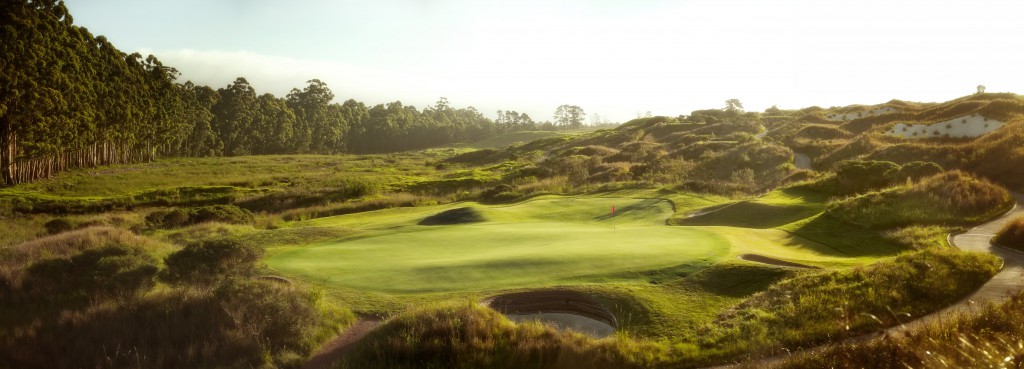The manufactured nature of The Links golf course at Fancourt Country Club on South Africa’s famous Garden Route will forever divide opinions. Those who like to play their golf in pure, natural environments rather than those created by man will find fault and point out that it isn’t a proper links at all. Others, myself included, will praise it as a modern day masterpiece whose design, despite challenging the abilities of even the best of players, has produced an utterly enjoyable experience.
It was the current Fancourt owner Hasso Plattner who decided he wanted to create a links style course and in the late 1980s he hired Gary Player and his team to come up with something different. The resort already had two excellent parkland layouts, the Outeniqua and the Montagu, so the plan was to conjure a course that would complement the existing pair.
It was a bit of challenge to say the least – the area chosen for the course was as flat as a pancake and had previously served as an airstrip.
The solution was to tip thousands of tons of earth over the land and move it about with bulldozers to create contoured fairways, undulating greens, pot bunkers and hilly mounds separating the holes. From the start the intention was to create a natural feel, so a few lakes were added for good measure and the whole expanse was planted with native flora.
Now, less than 15 years after the first ball was struck, nature has knitted the whole project together and it appears as if the course has been there forever.
There is no denying the fact that this is not a true links course. The fairways are rather generous and despite their humps and hollows they are far lusher than you would find on a true Scottish links. You don’t get the run as you would at Turnberry for instance, however the greens seem more authentic and despite some criticism of the manufactured nature of the dunes, they appeared pretty natural to me. Much care has been taken to ensure the predominance of indigenous species and this along with the total absence of surrounding properties has given the entire place a natural rugged beauty. All of the holes seem to be enclosed by the rolling landscape giving your fourball an intimacy with the environment and its wildlife. The ponds look as if they are natural features and don’t often present a hazard, but are more of a sight to enjoy.
This, however, is not a golf course for novices and it has been deliberately designed to test the abilities of low handicappers. Players of a more modest ability will not find it overly difficult as long as it is not windy and they can get the ball off the tee. However, don’t expect your A game to be mirrored by your score. I played very well off my then 10 handicap here, although pars were hard to find so I’m afraid I haven’t framed my scorecard and hung it on my personal wall of fame.
It has a rather deceiving opening hole – a relatively short par four with an undulating green guarded by a single bunker to the right so it doesn’t seem very difficult.
The course immediately toughens up, with a 200-yard carry to the par three second. It’s a downhill shot, but there is rough to either side and beyond the green, and bunkers are dotted about all over the place. It features a huge, rolling green and a par here is very welcome. The third is even harder, a long par four with an elevated green perched behind a walled burn. You will notice here too that there isn’t much rough – if you are more than a few feet wide of the fairway you will be in a bush – a typical feature of the course.
By this stage you should have realised what a wonderfully varied course The Links really is and the experience continues. Gary Player wanted this to test single figure golfers with a series of challenges. You need to be reasonably long off the tee, straight, have good course management skills, be able to read putts well and from time to time, recover from some deep pot bunkers.
There are lots of memorable holes – the long daunted par three 17th sticks in my mind, while the 12th par four and the awesome par five 16th provide a great challenge and much pleasure.
While it should be on any serious golfer’s “must play” list, it is not exactly easy to get on it. The course is very exclusive, open to its 63 members, their guests, and a limited number of people staying at the Fancourt Resort. As a result it isn’t cheap by South African standards. Expect to pay about £130 a round (1850R) which includes your compulsory caddie and lunch at the halfway house.
The first time I visited, in 2009, I was not granted access although I was a visiting golf writer and resident at the resort. In those days only 16 hotel residents could play each day. Luckily the worldwide recession has seen a relaxation of this number.
It is currently ranked number two behind Leopard Creek in a country where the golf courses are truly memorable.
Fancourt professional Neil Walsh Tucker can’t get to play The Links too often. He said: “There isn’t one bad hole on The Links. People always look forward to playing it, as it is a truly great golfing experience. It is not really a links – the fairways are pretty generous, the ball doesn’t run like it does in Scotland and you have to fly your ball to the green. But it is a phenomenal golf course whose conditioning is always immaculate.
“You might feel daunted by it at first sight but my advice to you is play it as if you haven’t got a care in the world – just go for it.”
For more details see www.fancourt.com


